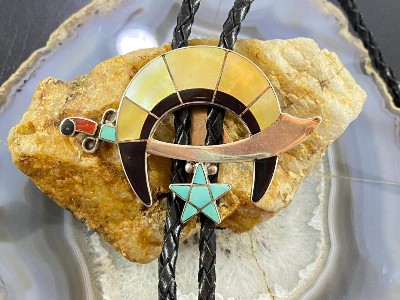Affiliate Disclaimer: We work to provide bolo ties and locate merchants who sell the products you are looking for. If you make a purchase from any of the merchants we endorse, we will earn a small commission at no additional cost to you. Thank you for your support!
Quandelacy family of Native American jewelers and their important contributions to Southwestern jewelry

The Quandelacys - A Family Legacy in Hopi Silver Overlay Jewelry
Among names representing pioneering Native American jewelers, one Hopi family stands tall for pushing Hopi silverwork to new heights of beauty and technique - the Quandelacys. Using overlay metalsmithing passed through generations, the Quandelacy family perfected filigreed jewelry sculpting that wonderfully showcases Hopi culture. Their award-winning bracelets, rings and bolo ties remain sought after collector pieces.
Late 1800s Origins
The earliest record of Hopi jewelry craftsmanship begins with silversmith Ashe Kukuongva in the 1870s. His ingenious use of melted coins to shape silver overlay plates revolutionized jewelry making. It provided thinner, durable sheets that could be intricately etched using otherworldly Hopi designs then soldered onto base silver. This birth of "Hopi overlay", allowing more relief and complexity, heavily influenced famed descendant Charles Loloma. But before Loloma redefined 20th century Hopi jewelry, one family helped usher overlay methods into wider popularity - the Quandelacys.
Quandelacy Family Innovations
It was Charles Quandelacy in the early 1900s who first expanded his father Mitchel Quandelacy's more basic silverwork by incorporating period-specific naja and squash blossom necklaces using overlay. Charles also standardized the corn stalk and tiponi patterns still iconic in Hopi jewelry today. Along with his brother Mitchell Lansa Quandelacy Sr. in the 1930's, their designs grew respected for precise lines and contrasting textures. The brothers passed their metalsmithing knowledge to Lansa's sons, M. Lansa Jr. and Herman Quandelacy in the 1940s just as demand for native jewelry flourished across America.
The second Quandelacy generation came to define overlay jewelry aesthetic with award-winning symmetry and dimension. They took inspiration from ancient broken pottery shards discovering that bonding ultra-thin textured silver sheets over base contours enabled artistry and utility through jewelry. It provided ideal surfaces for chasing complex motifs. Lansa Jr. enhanced his family's corn traditions by angling corn tips across bracelet bands and introducing corn maidens beside corn mothers. Herman focused on swirling, rounded edges visible in his bolo ties. Combined, the Quandelacys signature SW American native patterns and pendant sculpting, all while accelerating the overlay technique itself.
Collectibility Today
All Quandelacy overlay work from the 20th century onward is passionately collected today. Websites like ATADA.org provide guides for identifying Quandelacy hallmarks - ranging from Hopi clan symbols and corn imagery to the specific consistency of silver textures preferred by each jeweler generation. Every hand engraved "Q" initial confirms a Quandelacy heirloom. Their early adoption and improvement of soldering overlay plates enables Hopi jewelry durability and is still relied upon by artists today when hand fabricating multi-dimensional works. Even as contemporary trends shift, Quandelacy pieces remain A-List prized artifacts for galleries and auction houses like Heritage Auctions due to their rich history advancing Native jewelry craft for over a century.
Thatlegacy continues through active artisans like Herman's son Duane Quandelacy and grandson Kyle, carried by passion for Hopi culture, precision, and preservation through silver. For their century elevating Hopismithing's place on the national scene, the Quandelacy surname retains prestige amonst collectors and legacy within Southwest jewelry terrain.

Old Pawn Quandelacy Bolo Ties
References
Wheelwright Museum - Quandelacy Family LegacySouthwest Indian Arts Association - Quandelacy Family Heritage
NMAI - Quandelacy Family Contributions
Adobe Gallery - History of the Quandelacy Family
Four Winds Indian Trading Post - Quandelacy Family Story




